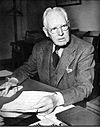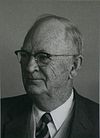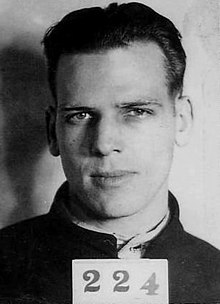The Rock
1,675 feet (length) by 590 feet (width), its highest point 135 feet above the Pacific Ocean, the 22 acres of rock bearing the Spanish word for pelican lays 1.25 miles off the California coast, and prior to its use as a Federal prison, serves the United States government (purchased by John C. Fremont for $5,000 during the Bear Flag Rebellion) as a lighthouse, coastal fortification protecting San Francisco, a storage area for firearms (to keep them out of the hands of Confederate sympathizers during the Civil War), and as a military prison for the United States Army. Acquired by the United States Department of Justice on October 12, 1933, the facilities on the island are modified and expanded into a penitentiary designed to hold notorious convicts and inmates with records of causing troubles at other facilities. Guarded by 60 special FBI, U.S. Marshals, and railroad security officers, at 9:40 in the Saturday morning of August 11, 1934, the prison and its staff of 155, accepts its first batch of 137 handcuffed prisoners from Leavenworth Penitentiary in Kansas and the McNeil Island Penitentiary in Washington.

Alcatraz - 1895
Built for security, not rehabilitation, with a capacity for 315 prisoners, the facility consists of an enclosed three-story cellhouse divided into four blocks of cells, labeled A, B, C, and D (where the prisoners were sent for the additional punishment of solitary confinement in "dark" cells), two barred gun galleries, the warden's office, a visitation room, a library, a barber shop, a dining room and kitchen (three meals a day are provided to both convicts and guards), and above the dining hall, a small hospital. The cell each convict is essentially assigned to do not adjoin to any outside walls and consist of a barred room that is 9 feet long, five feet wide, and seven feet tall, and contains bed, desk, washbasin (cold water only until the 1960s), and toilet against the back wall (flushed with salt water from the ocean), and basically have no furnishing other than a blanket ... a vent covered by a metal grill measuring 6 inches by 9 inches lets in air from the utility corridor behind the cells Outside the cellhouse there is a walled-in area for brief bouts of recreation, an Industries building (jobs are considered a privilege), a dock area, facilities for guards and their families, and armed gun towers with searchlights (along with locks, bars, and guards, convicts moving from various areas must pass through metal detectors). A prison meant to house the "worst of the worst" (among the convicts that spend time on The Rock are Al "Scarface" Capone, the "Dean of Bankrobbers," Harvey Bailey, the "Birdman of Alcatraz, murderer, Robert Franklin Stroud, kidnapper George "Machine Gun" Kelly, Los Angeles gangster Mickey Cohen, Boston mob boss Whitey Bulger, Harlem kingpin "Bumpy" Johnson, U.S. Capitol building shooter Rafael Cancel Miranda, Barker Gang robber and killer Arthur "Dock" Barker, and Public Enemy #1, bank robber and kidnapper, Alvin "Creepy" Karpis, who will spend more time incarcerated on Alcatraz Island than any other prisoner), the facility quickly picks up a reputation for its hostile conditions (on November 13, 1937, murderer Ed Wutke will become the first prisoner on the island to commit suicide ... he will not be the last) and being escape-proof.

Convict Recreation - Machine Gun Kelly Without Hat
 Layout
Layout Cellhouse
CellhouseCellhouse And Recreation Area
 Wutke
WutkeDuring its existence as a Federal prison, four men will administer the facility as wardens for the Department of Justice ... James A. Johnston from 1934 to 1948, Edwin B. Swope from 1948 to 1955, Paul J. Madigan from 1955 to 1961, and Olin G. Blackwell from 1961 to 1963. 1,576 prisoners will experience the Alcatraz hard of the four wardens ... and in 14 different attempts, 36 convicts will attempt to leave the island before their sentences are fully served.




L to R - Johnson, Swope, Madigan, And Blackwell
Willing to brave bars, guards, razor sharp rocks, sharks, and seasonal waters in San Francisco Bay that average 53 degrees and have a current that can exceed six knots, the escape attempts begin in 1936 and end in 1962:
*4/27/1936 - While burning trash in an outside incinerator, Joseph Bowers (40, serving a 25-year sentence for mail robbery) suddenly breaks into a run, climbs a chain link fence and ignores commands that he surrender ... shot, he falls fifty feet and dies.
*12/16/1937 - Theodore Cole (25, serving a life sentence for an Oklahoma robbery and murder) and Ralph Roe (32, serving a lie sentence for partnering with manic Wilbur Underhill ... he is captured in the same gun battle that claims the life of the "Tri-State Terror") file their way out of the Industries Building on a foggy day, make their way down to the water, and slip away from the island, believed drowned by both the convicts and the authorities.
*5/23/1938 - Rufus Franklin (24, at Alcatraz for on a 30-year beef for bank robbery, car theft, and assault), Thomas Limerick (36, serving a life sentence for bank robbery), and James Lucas (26, serving a 30-year sentence for Texas bank robbery and trafficking in stolen vehicles ... on Alcatraz he is also the convict who attacks Al Capone with a pair of scissors for cutting to the front of the line to get his hair cut in the prison's barber shop), kill guard Royal Cline (36) with a claw hammer, make their way to the roof of the Industries Building. On the roof, Franklin and Limerick will be gunned down (Limerick is killed by a round to the head) by the tower guard on duty (Franklin survives his shoulder wound and gets life for murder, he dies behind bars in 1975 at the age of 59), and Lucas surrenders (receiving a life sentence also, he is eventually freed and dies in Sacramento in 1998 at the age of 86).
 Lucas
Lucas*1/13/1939 - Dock Barker (40, serving a life sentence for the kidnapping of St. Paul banker Edward G. Brenner), William Martin (25, serving 25 years for post office robbery), Rufus McCain (36, serving 99 years for kidnapping during a failed Oklahoma bank robbery, Henri Young (28, sentenced to 20 years for a Washington bank job), and Dale Stamphill (27, in for life for the kidnapping of Dr. Fred L. Meyers after an Oklahoma bank robbery) saw their way out of their cells, pry open the bars to an outside window, and make their way to the water ... until cornered by guards, four of the men surrender, but Barker and Stamphill continued to try to escape on the driftwood raft they have crafted, actions that get Stamphill shot in both his legs, and Barker dead from wounds to his neck and head. Later, supposedly for botching the escape, Young will kill McCain, stabbing his former partner in the stomach.
*5/21/1941 - Joseph Paul "Dutch" Cretzer (28, in for life for bank robbery, murder, and an escape attempt in Tacoma, Washington), Lloyd Barkdoll (47, life for an Oregon bank robbery), Arnold Kyle (27, Cretzer's brother-in-law and bank robbing partner serving a life sentence), and Sam Shockley, (31, serving a life sentence for bank robbery and kidnapping in Oklahoma) take three guards prisoner in the Industries Building (Clyne Stoops, Lionel Johnstone, and Captain Paul Madigan), along with Superintendent of Industries, C.J. Manning, but realizing they can't grind through the bars of the mat shop, surrender to Madigan after two hours.
*9/15/1941 - On garbage detail, John Richard Bayless (27, serving 25 years for bank robbery in Missouri) manages to slip into the fog and reach the south side of the island ... realizing after moments he will drown if he continues to swim towards San Francisco, he quickly makes his way back to shore and surrenders.
*4/14/1943 - James Boarman (24, in for 20 years for bank robbery), Harold Brest (29, serving a life sentence plus 50 years for bank robbery and kidnapping), Floyd Hamilton (36, the former friend of killer Clyde Barrow, and the brother of executed murderer Raymond Hamilton, at Alcatraz on a 30-year term for bank robbery), and Fred Hunter (43, the former running mate of Alvin Karpis, serving a sentence of 25 years for robbery and harboring Karpis) put together an escape that includes getting out of the mat shop, assembling empty cans into a flotation device, tying up two guards (including Captain of the Guards, Henry Weinhold, covering themselves in grease, and jumping off a 30 foot cliff into the water ... alarm sounded however before they can get away, tower guards fire on the men, killing Boarman, Brest surrenders to guards in the prison's launch, an injured Hunter surrenders after he takes refuge in a nearby cave, and worn out after three days of exposure hiding in the same refuse filled cave, Hamilton surprises guards by climbing out of his hiding place, making his way back to the window he had jumped out of, and hiding under a pile of material in the storeroom of the Industries Building, where Weinhold finds him while searching for items used in the failed escape.
*8/7/1943 - Ted H. Walters (30, serving a 30[year term for bank robbery, assault, and auto theft in Arkansas) sneaks out of a door in the prison laundry and makes his way to the western side of the island ... where missed and alarms sounded, he is captured by the prison's beach patrol.
*7/31/1943 - John Giles (50, serving 25 years for the attempted robbery of a Denver & Rio Grande Western mail train) almost gets away ... gathering components under the prison's pier of an Army Staff Sergeant's uniform from the prison laundry, Giles jumps aboard the Army launch of General Frank M. Coxe as it completes its business at Alcatraz and heads for nearby Fort McDowell, but an unexpected convict count shows him missing, and guessing as to his whereabouts, he is met as he departs the boat by Assistant Warden E.J. Miller, who taken a speed boat to the army post (with an assist from Lt. Gordon Kilgore who notices tat the convicts uniform is not correct).
*5/2 - 5/4/1946 - Clarence Carnes (19, serving life for kidnapping, robbery, and murder), Bernard Paul Coy (46, serving 25 years for bank robbery in Kentucky), Dutch Cretzer (35, serving life for aforementioned crimes plus his failed Alcatraz escape attempt of 1941), Marvin Hubbard (34, serving life for robbery, prison escape, and kidnapping), Sam Shockley (36, as with Cretzer and the 1941 escape attempt), Miran Edgar "Buddy" Thompson (29, serving life for kidnapping and murder in Texas) participate in a flawed escape that has the men procure weapons from the prison's west gun gallery (Coy finds a way to climb three stories, pry the bars apart, and gain the guard Bert Burch's' weapons after the men have a savage fist fight) but get trapped inside the cellhouse when they accidentally jam the lock leading outside ... in the mayhem that ensues, guards William Miller and Harold Stites are killed by Cretzer, eleven corrections officers and one convict not involved in the breakout are wounded, Marine support is called in, Cretzer kills Coy in one of the prison's utility corridors, Hubbard and Cretzer are gunned down in the same utility corridor by guards armed with machine guns and shotguns, Thompson and Shockley are found guilty of murder and executed in the San Quentin gas chamber, and Carnes receives another life sentence to serve (he eventually is released in 1973, breaches the terms of his parole, and is sent back to prison where he dies of AIDS in 1988 at the age of 61).

Shooting Up The Cellhouse
 Hubbard, Coy & Cretzer
Hubbard, Coy & Cretzer Carnes, Shockley, and Thompson
Carnes, Shockley, and Thompson *7/23/1956 - Floyd Wilson (41, serving life for murder during a bungled robbery attempt) slips away from a work detail and hides in a depression at the foot of some cliffs on the south end of the island ... unable to build a raft and unwilling to get in the water, he surrenders to authorities when he is found eleven hours later.
*9/29/1958 - Aaron Walter Burgett (28, serving 28 years for a Missouri post office robbery) and Clyde Johnson (40, serving 40 years for bank robbery in Tennessee) while outside the walls on garbage detail on a foggy afternoon, use a shiv to take guard Harold Miller hostage while they wait on an escape boat that never shows ... alarm sounded when the three men are missed, Miller is released from the tree he has been tied to, Johnson is recaptured standing hip deep in the Bay's cold waters, and after thirteen days, the body of Burgett is discovered drowned, his wooden flippers and plastic bag having failed to keep him afloat.
*6/11/1962 - Clarence Anglin (31, serving 17 years for bank robbery in Alabama), John William Anglin (32, doing 10 years for the same crime as his brother), and Frank Lee Morris (35, serving 14 years for bank burglary in Slidell, Louisiana), after months of planning and preparation that includes the creation of dummy heads, make their way out of the air vents in the back of their cells, climb to the top of a utility corridor, climb though an air vent to the cellhouse roof, lower themselves to the ground, make their way over a wall, and using flotation devices of their own creation, vanish into the San Francisco night without any of the guards knowing it, never to be seen again ... a caper that will be made into a major Hollywood movie starring Clint Eastwood, and an escape that many believe the convicts pull of, despite authorities claiming all they men have drowned.
 Morris's Dummy Head
Morris's Dummy Head*12/16/1962 - Darl Lee Parker (31, serving 50 years for bank robbery, kidnapping, and an attempted escape) and John Paul Scott (35, serving 30 years for bank robbery and possession of an unregistered gun), while on culinary duty, manage to cut their way through the bars of a storage room in the kitchen, make their way to the western end of the island, using "water wings" made of surgical gloves and prison shirt-sleeves, swim away from the island ... within 25 minutes of an alarm going out that the men have gone missing, Parker is found clinging to a pile of rocks 100 yards off the island called "Little Alcatraz," while the next morning, authorities receive notice of a body being spotted under the Golden Gate Bridge, on the rocks near Fort Point, three miles west of the prison. It is Scott, but he is not dead, only unconscious and suffering from shock ... revived, he is returned to Alcatraz (transferred to Leavenworth when Alcatraz closes, and then the Federal pen at Marion, Illinois, he makes another escape attempt there, is caught, sent to the Oak Park Heights prison in Minnesota, and eventually dies behind bars at the Federal Correction Facility at Tallahassee, Florida in 1987 at the age of 60).
In the aftermath of the Morris and Anglin's escape (there is an abundance of finger pointing as to who and what is responsible for the prisoners getting out of their cells and vanishing), with structural damage caused by the salt water and air that will cost millions to fix (in 1961 a group of engineers determines that repairing the prison is a lost cause), with the facility more than three times costlier to run than other prisons in the Federal system, Attorney General Robert F. Kennedy decides to close Alcatraz and open a new penitentiary in Marion, Illinois. Convicts transferred, the prison closes on March 21, 1963 ... but lives on in movies, books, television shows, the memories of guards and convicts that served there, and as a tourist destination making millions off its 1.5 million annual visitors for the city of San Francisco and the Federal government.

Where Public Enemies Were Once Kept
No comments:
Post a Comment